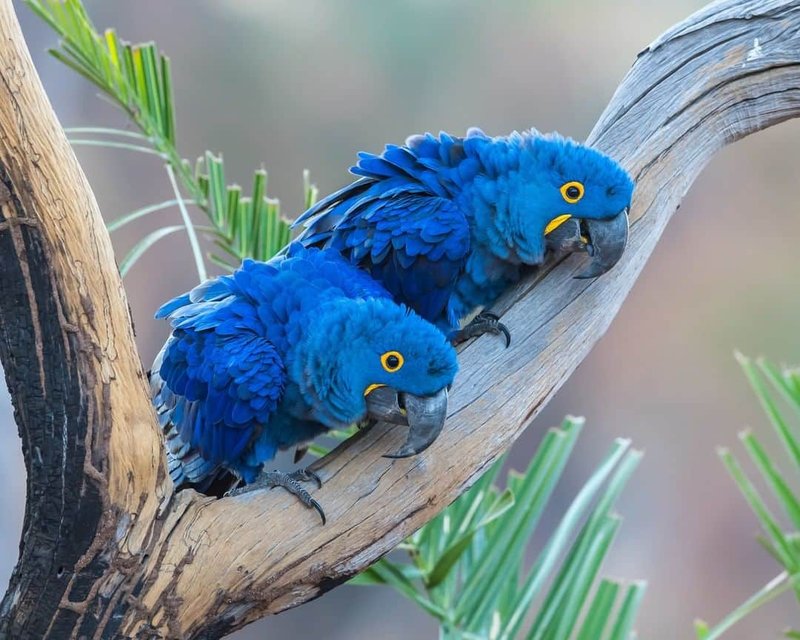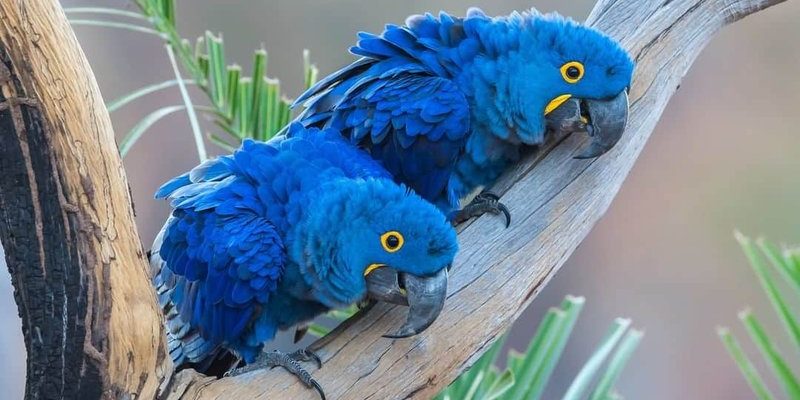
In this article, we’re diving into the differences between the Hyacinth Macaw and other similar bird species. Whether you’re a birdwatcher, a pet enthusiast, or just curious about our feathered friends, you’ll get a clearer picture of what makes the Hyacinth Macaw so special and how it compares to others like the Blue-and-yellow Macaw or the Scarlet Macaw. Let’s spread our wings and explore!
What Makes the Hyacinth Macaw Unique?
The Hyacinth Macaw is known for its striking appearance. With rich cobalt blue feathers that shimmer under the sunlight, it’s hard to miss this beauty in the wild. What truly sets it apart, though, is its size. This macaw is the largest flying parrot species, measuring up to 40 inches in length. Its long tail and robust beak are not just for show—they’re designed for cracking open tough nuts, which is a primary part of its diet.
In terms of behavior, the Hyacinth Macaw is incredibly social and intelligent. They often live in monogamous pairs, showcasing strong bonds with their mates. Like any good friend, they communicate clearly, using a range of squawks and whistles. If you’ve ever seen a Hyacinth Macaw, you might’ve noticed how they interact with each other—screeching and flapping their wings in playful displays. It’s truly a sight to behold!
You might be wondering why their conservation status is important. Sadly, Hyacinth Macaws are classified as vulnerable, with habitat loss and illegal trapping being significant threats. Understanding their uniqueness can help us appreciate the importance of protecting their environments.
Hyacinth vs. Blue-and-yellow Macaw
Now, let’s talk about another popular macaw: the Blue-and-yellow Macaw. At first glance, they might look a bit similar, but there are distinct differences. For one, the Blue-and-yellow Macaw is smaller, averaging about 33 inches in length. Their vibrant yellow underparts and mixed blue wings give them a cheerful look, yet they don’t boast the same deep blue hue as the Hyacinth.
Behaviorally, Blue-and-yellow Macaws are known for their playfulness and curiosity. They’re often more vocal than their Hyacinth cousins, which can make them a bit more entertaining to have around. While Hyacinth Macaws tend to have deeper, more resonant calls, Blue-and-yellow Macaws have a lighter, more whimsical tone.
When it comes to diet, both species enjoy a mix of nuts, fruits, and seeds. However, Blue-and-yellow Macaws have a broader palate and can adapt to different food sources more easily. This adaptability makes them somewhat more resilient to changes in their environment compared to the Hyacinth Macaw.
Hyacinth Macaw Compared to Scarlet Macaw
The Scarlet Macaw is another fascinating species that shares the same rainforests as the Hyacinth Macaw. With its eye-catching red, yellow, and blue plumage, the Scarlet Macaw is often recognized as one of the most beautiful parrots in the world. While both macaws share a similar habitat, they have distinct differences.
Size is a major point of distinction. The Scarlet Macaw is somewhat smaller at about 34 inches in length. This difference in size also contributes to variations in their flight patterns and behavior. Scarlet Macaws are known for their acrobatic flying abilities, often performing impressive aerial displays, while Hyacinth Macaws fly more steadily and gracefully.
In terms of social behavior, both species are highly social and intelligent. However, Scarlet Macaws tend to be more vocal and have a larger repertoire of sounds. While Hyacinth Macaws are more reserved in their vocalizations, Scarlet Macaws can chatter and squawk incessantly.
Dietary preferences also differ. Scarlet Macaws enjoy a variety of fruits and seeds but are often less reliant on hard nuts compared to Hyacinth Macaws. This flexibility in diet can help them adapt to varying food availability.
Similarities Among Macaws
While each macaw species we’ve discussed has its traits, they share a lot of common ground too. For starters, macaws are social creatures. They can often be seen flying in groups or engaging in playful antics. Being in the company of other macaws seems to bring them joy, and they communicate through body language and vocalizations.
All macaws also require spacious habitats as they love to explore and play. If you’re considering owning a macaw, it’s essential to provide them with ample space. Not only do they need room to fly, but they also require stimulating environments with toys and activities to keep them engaged.
Additionally, macaws have similarly strong beaks designed to crack open nuts and seeds. This shared trait highlights their evolutionary adaptation to their habitats, emphasizing the importance of dietary needs across the different species. With proper care and attention, all macaws can thrive in a loving environment, whether in the wild or as pets.
Common Habitats and Conservation Efforts
The Hyacinth Macaw primarily thrives in the Brazilian savanna and the Pantanal, an area of tropical wetland. Similarly, other macaws inhabit areas across Central and South America, adapting to specific ecological niches. These habitats are crucial, as they provide food and nesting sites, allowing these beautiful birds to flourish.
However, due to deforestation and habitat encroachment, the populations of Hyacinth and other macaws are declining. Conservation efforts are underway to protect these incredible animals. Organizations are working to preserve their habitats and educate local communities about the importance of these birds and the roles they play in their ecosystems.
You might be surprised to learn that ecotourism also plays a role in conservation. By creating opportunities for birdwatchers and nature lovers to see these macaws in their natural habitats, local economies can thrive, providing incentive to protect the environment rather than destroy it. This cycle of preservation and appreciation shows just how interconnected our world is.
The Importance of Choosing the Right Companion Bird
If you’re thinking about bringing a macaw into your home, it’s crucial to choose the right species that fits your lifestyle. Hyacinth Macaws, while stunning, have specific needs and can be more demanding in terms of space and social interaction. They thrive on mental stimulation and daily interaction, which requires a significant time commitment.
On the other hand, Blue-and-yellow and Scarlet Macaws may also require similar attention but can have different temperaments. For instance, if you’re looking for a bird that enjoys being the life of the party, a Scarlet Macaw might fit the bill better. However, if you’re captivated by the unique charm of the Hyacinth Macaw, be ready for a more nuanced experience—one that’s filled with both challenges and rewards.
Understanding these differences is vital to ensuring a happy and healthy relationship with your feathered friend. After all, choosing a companion bird should be an informed decision, ensuring both you and your bird are compatible in your expectations and lifestyle.
The world of macaws is vibrant and diverse, and the Hyacinth Macaw stands out as one of its most magnificent representatives. Its size, coloration, and unique behaviors set it apart from other parrot species, while also connecting it to them through shared habitats and social structures.
By understanding the differences between the Hyacinth Macaw and its feathered relatives like the Blue-and-yellow and Scarlet Macaw, we gain deeper insights into their lives and the challenges they face. Whether you’re a bird lover, a conservationist, or someone curious about the beauty of these creatures, appreciating their individuality helps us celebrate the incredible diversity of our planet.
So, next time you spot a brilliant flash of blue in the sky, you can think of the remarkable Hyacinth Macaw and all its avian friends. Let’s continue to protect their habitats, so future generations can enjoy their beauty and grace too!

